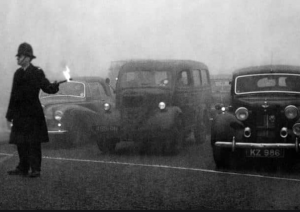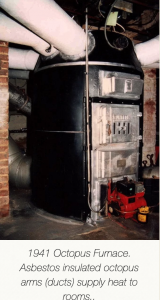In December of 1952, the citizens of London woke to an impenetrable fog that covered the city overnight. This was not the first time London had been shrouded in a mist. Since the industrial revolution, London’s natural climate has mixed with smoke, creating a thick smog with a yellowish hue, giving rise  to its common nickname, “pea-soup”(20). Because of the regularity of smogs rolling into London, the citizens were not particularly concerned in the beginning. The fog was simply a part of everyday life, or at least that was what the citizens assumed until reports on the deaths started to come out. The fog that coated the city lasted for 5 days, resulting in thousands upon thousands of casualties. By the end of the month, at least 12,000 people were dead, a number which governmental figures initially took steps to hide in an attempt to minimize panic and lesson future action they would have to take. Most of the deaths resulted from the young and old citizens succumbing to attacks of bronchial asthma and pneumonia.
to its common nickname, “pea-soup”(20). Because of the regularity of smogs rolling into London, the citizens were not particularly concerned in the beginning. The fog was simply a part of everyday life, or at least that was what the citizens assumed until reports on the deaths started to come out. The fog that coated the city lasted for 5 days, resulting in thousands upon thousands of casualties. By the end of the month, at least 12,000 people were dead, a number which governmental figures initially took steps to hide in an attempt to minimize panic and lesson future action they would have to take. Most of the deaths resulted from the young and old citizens succumbing to attacks of bronchial asthma and pneumonia.
The smog was everywhere. Survivors say that they could barely see their hands through the denseness if they held it in front of their faces. Danger lurked in every corner amid the smog, so much so that even crossing the street became a feat that the bravest would not dare attempt. This was a particularly dangerous time for those who worked in vehicular  transportation. During the time of the incident, London had just opted to replace their cleaner and more renewable buses with shiny and new gas-guzzling vehicles, far worse for the environment(2). Drivers now struggled with learning new machinery among the blinding fog. Both buses and cars were escorted by people carrying large lanterns to signal that the vehicle was coming. In an interview conducted about the fog, Steve Jones, a bus driver claims it felt like “fog was sticking to the window like paint”(3). There were, of course, warnings not to d
transportation. During the time of the incident, London had just opted to replace their cleaner and more renewable buses with shiny and new gas-guzzling vehicles, far worse for the environment(2). Drivers now struggled with learning new machinery among the blinding fog. Both buses and cars were escorted by people carrying large lanterns to signal that the vehicle was coming. In an interview conducted about the fog, Steve Jones, a bus driver claims it felt like “fog was sticking to the window like paint”(3). There were, of course, warnings not to d rive in the terrible fog, but many did not listen. The official advisory stated that people should try to stay inside due to the visibility issues, but many people still braved the outside world in order to get to their jobs. Perhaps if they knew that vision impairment was not the only risk of the fog, but lung damage and other health issues as well, fewer people would have traversed the mist-laden streets.
rive in the terrible fog, but many did not listen. The official advisory stated that people should try to stay inside due to the visibility issues, but many people still braved the outside world in order to get to their jobs. Perhaps if they knew that vision impairment was not the only risk of the fog, but lung damage and other health issues as well, fewer people would have traversed the mist-laden streets.
This scene is immensely unnerving. Each day the citizens thought that the fog would lift, but continued to persist for those cold 5 nights. To try to stay warm and have access to light, nearly every household lit their coal fireplaces at nights and even into the day. Little to their knowledge, this only made the disaster worse, as coal smoke from fireplaces only contributed to the smog. In the 1900s, the people of London used coal furnaces to heat up their houses, letting toxic fumes seep into the air. Similarly, big factories did the same but on a much larger scale. The pollution in 1952 was immense, and in a normal circumstance, it would simply escape into the atmosphere on the first night of the smog, an anticyclone settled over London, trapping pollution in the city inself, flush against the cobblestone pathways. Burning coal releases sulfur dioxide and nitrogen dioxide, which interact with water droplets that were common in the London skies. Initially, the water particles in the fog were large enough to dilute the acid, forming a near-neutral fog. But as water vapor evaporated, the fog became acidic, eventually concentrating so strongly that breathing it in was enough to damage the lungs(6).
In the 1900s, the people of London used coal furnaces to heat up their houses, letting toxic fumes seep into the air. Similarly, big factories did the same but on a much larger scale. The pollution in 1952 was immense, and in a normal circumstance, it would simply escape into the atmosphere on the first night of the smog, an anticyclone settled over London, trapping pollution in the city inself, flush against the cobblestone pathways. Burning coal releases sulfur dioxide and nitrogen dioxide, which interact with water droplets that were common in the London skies. Initially, the water particles in the fog were large enough to dilute the acid, forming a near-neutral fog. But as water vapor evaporated, the fog became acidic, eventually concentrating so strongly that breathing it in was enough to damage the lungs(6).
The smog was brutal, especially since its arrival was on the heels of World War II, a time in which the economy was facing a great downfall, and people had other matters on their hands. Many took The Great Smog as a sign of God, which was why a lot of inaction was done at first. A common thought was that the smog was really just a terrible weather incident that God had brought down upon the Londoners, something that they must suffer through until God lifted it(12).
The Great Smog lasted much longer than anybody imagined, and left a bigger impact on the citizens than the government originally predicted. During that week, 150,000 people were said to ask for admittance into the hospital, but because of the immense number of incoming patients, doctors did not have enough beds, nor the resources to keep all the people safe. Even more upsetting is the long term health implications that came to haunt the citizens forevermore. Recent studies have been done linking the root of asthma to air pollution, clearly tying in all of the parallels(9). It is intriguing that a disaster like this is not at the forefront of society’s minds, especially considering the encouraging climate activism that came with it. Some steps have been taken following the disaster. Four years after the event, one of the first global clean air legislation was passed. The 1956 Clean Air Act was groundbreaking legislation that inspired environmental shifts towards the regulation of smoke pollution. This legislation was pioneering for environmental movements all over the world.
